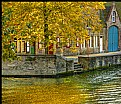
Chris Hunter
(K=25634) - Comment Date 5/21/2007
|
To a certain degree yes.
For me it goes like this:
Step 1. Shoot RAW and archive a copy in the RAW format.
Step 2. Open photo and save as a PSD or TIFF.
Step 3. Straighten horizon / buildings / subject as desired. Crop as to remove any background color remaining after rotating the canvas.
Step 2. Adjust color, levels, curves, saturation, etc.
Step 4. Crop if desired for composition.
Step 3. Save hi-res TIFF at this point.
Step 4. Re-open TIFF & resize, convert to profile, sharpen and save a copy as needed for whatever I'm using the photo for. (ie: for web use I'd resize to 800x600px or whatever is needed, convert it to sRGB and save it as a jpeg. For print use, I'd keep the pixel size the same, convert it to CMYK, sharpen and save as an EPS or TIFF)
The most important things to remember are:
Always sharpen last
Save a master copy that is unedited and un-cropped in the RAW format.
Convert to the specific profile and sharpen for the specific output (web, print, etc.)
|
|
|
|

Chris Hunter
(K=25634) - Comment Date 5/21/2007
|
Sorry.. numbering got messed up... myaybe on day UF will have a 'Edit Post' function like most forums do...
|
|
|
|

AJ Miller
 (K=49168) - Comment Date 5/21/2007
(K=49168) - Comment Date 5/21/2007
|
Many thanks, Chris. I appreciate your thoughts and note especially your advice to "sharpen last". When I get a chance, I will try to compare the effects of different task orders, but in the meantime will see how your suggestion turns out.
AJ
|
|
|
|

Doyle D. Chastain
 (K=101119) - Comment Date 5/21/2007
(K=101119) - Comment Date 5/21/2007
|
AJ:
Amazingly . . . I end up doing it like Chris listed. It seems to me that leveling the horizon and cropping must preceed any other adjustments . . . partly because the Histogram considers the entire image and I don't need information in my way that simply will not be in the final image. I have found color adjustment preceeding light adjustments works best since the light levels are going to affect color . . . then curves, saturation and sharpenening last.
Always save the master RAW file (of course) . . . then, when it's as I want it . . . save the TIFF . . . and resize for the appropriate use. Once I'm thinking the image is done . . . I review each of the previous steps in the stack independently.
Regards,
Doyle I <~~~~~
|
|
|
|

* James *
(K=20200) - Comment Date 3/16/2008
|
"Always save the master RAW file (of course)"
unless you delete the RAW file its always there. if you're using adobe camera raw (ACR) in PS, any file you save from your RAW image is additional to the RAW file. and when you save after using ACR you have to save in a format other than RAW, dont you? there is no option to save as RAW.
here's what i do:
1. open RAW file and make adjustments
2. save as .psd
3. open .psd
4. crop/rotate if necessary.
5. levels
6. hue saturation
7. brightness/contrast
8. resize (i always resize as a percentage, 40% for me with D70 and now D200)
9. sharpen
10. save as jpeg
i always keep the RAW image and the jpeg file that comes out of RAW.
i've just recently reversed 8 and 9 but i'm not sure why sharpening before or after resizing makes a difference. anyone care to point that out?
|
|
|
|

Doyle D. Chastain
 (K=101119) - Comment Date 3/17/2008
(K=101119) - Comment Date 3/17/2008
|
"unless you delete the RAW file its always there. if you're using adobe camera raw (ACR) in PS, any file you save from your RAW image is additional to the RAW file."
Not exactly. Some programs, CaptureNX, for example, allow you to save an image and the saved image, without a filename change, does write over the original RAW image. It does depend on the editing program one chooses to use. While you may be correct when it refers to the common usage . . . there are, in fact, some programs that would use the original and overwrite it.
Regards,
Doyle I <~~~~~
|
|
|
|
















